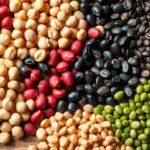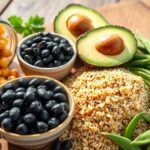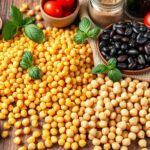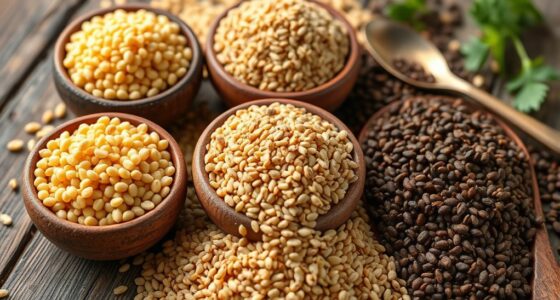Pulses like lentils, chickpeas, and beans are excellent plant-based sources of iron and protein that help you meet your nutritional needs. They provide essential nutrients for muscle repair, immune support, and energy, while their high fiber content promotes digestive health. Combining pulses with vitamin C-rich foods enhances iron absorption, maximizing their benefits. Plus, they’re sustainable, affordable, and versatile for many meals—if you want to learn how to incorporate more pulses into your diet, stay tuned.
Key Takeaways
- Pulses like lentils, chickpeas, and beans are rich sources of plant-based protein essential for muscle repair and immune health.
- They provide non-heme iron, supporting oxygen transport and energy, especially when combined with vitamin C-rich foods to enhance absorption.
- Incorporating pulses into meals—such as salads, soups, or spreads—is simple and helps meet daily protein and iron needs.
- Pulses are sustainable, eco-friendly sources that require less water and land, reducing environmental impact compared to animal proteins.
- Regular consumption of pulses promotes digestive health, maintains steady energy levels, and supports overall nutritional well-being.

Pulses, including lentils, chickpeas, and beans, are powerhouses of nutrition that can substantially boost your iron and protein intake. These versatile foods are packed with nutrients that support your overall health while also being easy to incorporate into various meals. Their pulses nutritional benefits extend beyond just iron and protein; they also provide fiber, vitamins, and minerals that contribute to your well-being. Because pulses are considered sustainable food sources, choosing them helps reduce environmental impact compared to many animal-based proteins. They require less water and land, produce fewer greenhouse gases, and can be grown in a variety of climates, making them an eco-friendly choice for your diet.
Pulses like lentils, chickpeas, and beans are nutrient-rich, sustainable sources of iron, protein, fiber, vitamins, and minerals.
When you include pulses in your meals, you’re tapping into their impressive nutritional profile. They are rich in plant-based protein, which is essential for muscle repair, immune function, and overall cell health. If you’re looking to meet your daily protein needs, pulses offer an excellent, affordable alternative to meat and dairy. Additionally, they are an outstanding source of iron, a mineral crucial for transporting oxygen in your blood and preventing fatigue. The iron found in pulses is non-heme iron, which is less easily absorbed than heme iron from animal sources. However, consuming pulses with vitamin C-rich foods like citrus or bell peppers can notably enhance iron absorption, maximizing their benefits. Incorporating pulses into your diet may also support sustainable eating habits and reduce your dietary carbon footprint.
Incorporating pulses into your diet is straightforward. You can toss cooked lentils into salads, blend chickpeas into smoothies or spreads, or add beans to soups and stews. Their mild flavor makes them adaptable to a wide range of recipes, allowing you to enjoy their pulses nutritional benefits without much fuss. Furthermore, eating pulses regularly can help you maintain steady energy levels and support long-term health due to their fiber content, which promotes digestive health and helps regulate blood sugar levels.
Choosing pulses as a regular part of your diet aligns with sustainable eating habits while ensuring you meet your nutritional needs. They are a smart choice for anyone wanting to reduce reliance on animal proteins, lower their carbon footprint, and still get enough iron and protein. As you diversify your diet with pulses, you’re not only nourishing your body but also making environmentally conscious decisions. So, next time you’re planning a meal, consider adding lentils, chickpeas, or beans—powerful, nutritious, and sustainable food sources that help you meet your iron and protein needs efficiently.
Frequently Asked Questions
Can Pulses Replace All Animal Protein Sources in My Diet?
Pulses can replace many animal protein sources, but they might not provide all nutrients you need. Pulses versus meat offer plant protein diversity, which benefits your diet, but they lack certain essential amino acids and nutrients like vitamin B12. To meet your nutritional needs, combine pulses with other plant-based foods or consider fortified products. Relying solely on pulses might leave gaps, so a balanced, varied diet guarantees you get everything your body needs.
How Do Cooking Methods Affect Nutrient Retention in Pulses?
Cooking techniques markedly impact nutrient retention in pulses. Boiling for too long can cause nutrient loss, especially water-soluble vitamins, while pressure cooking preserves more nutrients due to shorter cooking times. So, you should opt for methods like soaking and steaming to minimize nutrient loss. Using less water and cooking at lower temperatures also helps retain the pulses’ essential nutrients, ensuring you get the maximum health benefits from your meals.
Are There Any Health Risks Associated With Consuming Too Many Pulses?
Eating too many pulses can be like inviting trouble to your table. You might face allergic reactions, especially if you’re sensitive, or suffer from digestive issues like bloating and gas. While pulses are nutritious, overindulgence can turn beneficial nutrients into a burden. Keep moderation in mind, and listen to your body’s signals—your digestive system will thank you for the balance.
How Do Pulses Compare to Other Plant-Based Protein Sources?
Pulses are excellent plant-based protein sources, often surpassing grains and nuts in nutrient bioavailability. They provide essential amino acids and are rich in fiber and minerals. Compared to other plant sources, pulses are more environmentally sustainable, requiring less water and land. Including them in your diet boosts protein intake while supporting eco-friendly practices, making pulses a smart, nutritious choice for both health and sustainability.
What Are the Best Ways to Incorporate Pulses Into Everyday Meals?
You can easily incorporate pulses into your meals by planning simple recipes like hearty soups, flavorful salads, or comforting stews. Mix pulses into pasta dishes, mash them into spreads, or add them to grain bowls for extra protein. Meal planning helps you include pulses regularly, making your diet more nutritious. By experimenting with different recipes and incorporating pulses into your daily routine, you guarantee variety, flavor, and health benefits in every bite.
Conclusion
By including pulses in your diet, you’re opening a treasure chest of iron and protein that fuels your body and keeps you strong. Think of pulses as your nutritional superheroes, swooping in to save the day with their impressive nutrient profile. So, next time you’re planning your meals, remember that these humble legumes are your allies in meeting your health goals. Embrace pulses, and watch your energy soar like an eagle in the sky!
Ilana has been a vegan for over 10 years. She originally made the switch for health reasons, but soon found herself becoming more and more passionate about the ethical and environmental implications of a vegan lifestyle. Ilana is the author of The Graceful Kitchen, a blog all about veganism. She loves to cook up delicious and nutritious vegan meals, and share her recipes with others who are interested in leading a cruelty-free life. Ilana is also a strong advocate for using whole foods as the foundation of a healthy diet, and believes that going vegan is one of the best ways to achieve this.
















